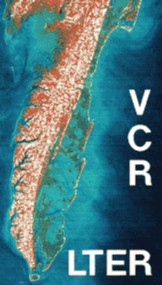 Low Altitude Remote Sensing and Mapping of Phragmites Utilizing Videography |

Barry Truitt
Virginia Coast Reserve
|
 Low Altitude Remote Sensing and Mapping of Phragmites Utilizing Videography |

Barry Truitt
Virginia Coast Reserve
|
Phragmites (P. australis), or common reed, is a native perennial wetland grass that has become an aggressive invader of wetland systems on the Eastern Shore during the past two decades. Concern is warranted for this species because it produces monotypic, almost impenetrable stands of eight to twelve foot high reeds that are displacing many beneficial wetland plants while providing little food value to wildlife.
In late winter/early spring of 1995, a cooperative project of The Nature Conservancy and the U.S. Fish & Wildlife Service was undertaken to aerially survey and map the relative distribution of Phragmites in the interior of the barrier islands and along the mainland upland/salt marsh ecotone from Assawoman creek south to the mouth of the Chesapeake Bay. The aerial survey utilized S-VHS-C format videography taken from a image stabilized shoulder mounted camcorder flown from a rotary wing gyro-copter by pilot/photographer David Temens. The average altitude was 75 to 100 feet and the average air speed was 50 knots. The overflights covered over 300 linear miles of the upland/salt marsh ecotone in the watersheds of the mainland and barrier islands and resulted in production of 5.5 hours of S-VHS-C video tape that was copied to high band 8 mm tape and viewed on a high definition television monitor with S-VHS inputs.
The stands of Phragmites were readily visible on the high band 8 mm tapes and the tapes showed that Phragmites is relatively widespread on the mainland upland/salt marsh ecotone and in the interior of the barrier islands. The Phragmites stands were then hand mapped from the tapes on both a copy of a 1985 series of ACOE aerial photography (1:12000) and on USGS topographical maps (1:24000) to show the relative distribution of Phragmites in the mainland watersheds and on the barrier islands.
Visual analysis and comparison of the videography, photos, and maps of the relative distribution with a series of maps showing former and active dredge spoil sites on the seaside provided by the ACOE shows a close correlation between the largest and densest stands of Phragmites and the active and former dredge spoil sites on the mainland. This analysis suggests that these dredge spoil sites were the original sites invaded by the Phragmites, with subsequent spreading by either seed or rhizome north and south and further into the watershed. On the barrier islands, there also seemed to be a correlation between areas newly invaded by Phragmites and lightning strike natural fires on north Parramore, south Wreck, south Myrtle, and south Smith Islands during the past decade. Other forms of disturbance on the mainland associated with the invasion of Phragmites include timber harvest and road, ditch, dike, and pond construction. Stands of Phragmites were also larger and denser on the upland/salt marsh ecotone adjacent to agricultural fields with little or no upland vegetative buffers and were noticeably absent in areas where watercourses were extremely short (east side of Upshur Neck), where bottomland hardwood swamps provided good buffering effects (Magothy Bay), and in areas of retrogressive strand plain fields (Machipongo River watershed). This suggests that nutrients from run off or groundwater seeps might play a facilitating role in the invasion of Phragmites.
The maps showing the relative distribution of Phragmites were utilized in the design of a limited chemical control program of Phragmites that was initiated this fall by the U.S. Fish & Wildlife Service on Fishermens Island and on the mainland adjacent to the Eastern Shore of Virginia NWR. Plans are presently underway to expand the aerial survey north from Assawoman Creek to the Maryland line in 1996, to scan the maps into a GIS for determination of a spectral image for Phragmites, and to repeat the whole aerial survey on a five year basis. New digital videography coming on line in concert with high resolution video monitors holds promise of increased resolution and expansion of this relatively cheap, low altitude remote sensing technology.
Marks, Marianne, Beth Lapin and John Randall. 1993. Element Stewardship Abstract for Phragmites australis. The Nature Conservancy, Arlington, VA.